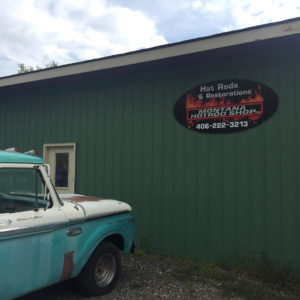 Livingston, Montana is a small ranching community of about 7,000, just north of Yellowstone National Park. Most of the town’s economic activity revolves around agriculture and tourism — being so close to Yellowstone brings in lots of travelers. Bozeman, which is about 30 miles away hosts a growing manufacturing and photonics industry. Despite these opportunities, students at nearby Park High School don’t always interact with industry leaders in the area, limiting their ability to explore different career options and weakening the talent pool for local business owners.
Livingston, Montana is a small ranching community of about 7,000, just north of Yellowstone National Park. Most of the town’s economic activity revolves around agriculture and tourism — being so close to Yellowstone brings in lots of travelers. Bozeman, which is about 30 miles away hosts a growing manufacturing and photonics industry. Despite these opportunities, students at nearby Park High School don’t always interact with industry leaders in the area, limiting their ability to explore different career options and weakening the talent pool for local business owners.
Last year Meagan Lannan, then manager at the Livingston, Montana Job Service office, along with several community leaders, decided to step in and ask educators how best to support a new work-based learning program to help close the gap and connect young learners with industry mentors. After studying states like Tennessee, Washington and California for inspiration and strategies, she built a coalition of key partners to launch a work-based learning program and engage more than 260 high school students in their first year.
So how did Lannan mobilize her town to go all in on work-based learning?
She started by securing buy in and support — including funding — from key business and education leaders in Livingston. After getting commitment from the Montana Department of Labor and Industry, the Montana State University Park County Extension, and Park High School, Lannan established a memorandum of understanding to clarify the roles of each partner. She also secured an agreement from the Arthur Blank Foundation, the charitable organization of Home Depot founder and philanthropist Arthur Blank, for four years of funding for a work-based learning facilitator pilot program.
Leveraging the relationships she cultivated at the job service office, Lannan was able to mobilize a network of Livingston business leaders to drive and provide work-based learning opportunities for high school students. It took a lot of time and effort to build and nurture these relationships, but Lannan’s hard work paid off. Once the community recognized the value and critical role in connecting learning with work, business leaders were on board.
In total, more than 260 work-based learning experiences were brokered through the first year of the pilot program. Experiences ranged from low-touch engagements such as guest speaking to more intensive internships, apprenticeships and more. Some employers even came into the classroom to teach a few classes under the teacher of record before leading students on a tour of their facilities. While several work-based learning experiences were in industries like agriculture or manufacturing that are considered high-demand in the Livingston area, students had the opportunity explore a variety of different careers. One student learned about wolf tracking in Yellowstone National Park. Another partnered with a local business to learn about sound wave engineering.
Providing work-based learning opportunities can be a challenge in rural communities, which often have a small employer base and limited industry presence. But, as Livingston, Montana discovered, a successful work-based learning program hinges on the support and buy-in of the community. Rural business leaders are often ready and willing to roll up their sleeves and, as Lannan puts it, help “raise the barn.” It just takes a thoughtful, coordinated strategy to generate buy in, secure sustainable funding and connect learners with the world of work.
To help state and local leaders develop a comprehensive plan to improve access to high-quality work-based learning and career pathways in rural areas, Advance CTE developed and released a rural strategy guide earlier this year. The guide, part of the CTE on the Frontier series, provides five strategies for rural leaders to replicate Livingston’s approach:
- Secure buy-in and commitment for new or ongoing reform
- Leverage regional, cross-sector partnerships
- Use data strategically to understand access gaps and assess impact
- Use technology to expand access and reach
- Invest resources to spark innovation
Ensuring access to high-quality career pathways in rural areas is a persistent challenge facing state and local leaders — but communities like Livingston, Montana defy the odds, recognizing the value of work-based learning and committing to expanding opportunities for students.
Thanks to Meagan Lannan, Work-Based Learning Facilitator Lead, for providing input into this story.
Austin Estes, Senior Policy Associate


 In Nebraska, rural districts have been undertaking a wholesale needs assessment of local Career Technical Education (CTE) program offerings under the state’s reVISION initiative. Under reVISION, school and district leaders examine regional labor market data and hear from local employers to determine whether or not the programs available to students are those that are most in-demand.
In Nebraska, rural districts have been undertaking a wholesale needs assessment of local Career Technical Education (CTE) program offerings under the state’s reVISION initiative. Under reVISION, school and district leaders examine regional labor market data and hear from local employers to determine whether or not the programs available to students are those that are most in-demand. 

 nts at Tolsia High School in West Virginia have created an industry-validated carpentry business within their classroom. Students at Haynesville Junior/Senior High School in Louisiana are connected with physical therapists, diesel mechanics, a marriage and family counselor and other industry professionals on a biweekly basis through virtual “micro-industry engagements.” In North Dakota, nursing students can earn their associate’s degree through one of four community colleges, while taking their classes at rural hospitals and health care facilities. And in Montana, a mobile laboratory is deployed across the state to engage students around various career opportunities.
nts at Tolsia High School in West Virginia have created an industry-validated carpentry business within their classroom. Students at Haynesville Junior/Senior High School in Louisiana are connected with physical therapists, diesel mechanics, a marriage and family counselor and other industry professionals on a biweekly basis through virtual “micro-industry engagements.” In North Dakota, nursing students can earn their associate’s degree through one of four community colleges, while taking their classes at rural hospitals and health care facilities. And in Montana, a mobile laboratory is deployed across the state to engage students around various career opportunities. When Todd County School District received a $103,000 grant in 2014 under Governor Dennis Daugaard’s
When Todd County School District received a $103,000 grant in 2014 under Governor Dennis Daugaard’s